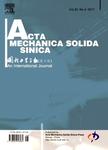Nonlinear buckling and postbuckling behavior of cylindrical shear deformable nanoshells subjected to radial compression including surface free energy effects
Nonlinear buckling and postbuckling behavior of cylindrical shear deformable nanoshells subjected to radial compression including surface free energy effects作者机构:Department of Mechanical Engineering Amirkabir University of Technology P.O. Box 15875-4413 Tehran Iran
出 版 物:《Acta Mechanica Solida Sinica》 (固体力学学报(英文版))
年 卷 期:2017年第30卷第2期
页 面:209-222页
核心收录:
学科分类:07[理学] 070205[理学-凝聚态物理] 08[工学] 080501[工学-材料物理与化学] 0805[工学-材料科学与工程(可授工学、理学学位)] 0702[理学-物理学]
主 题:Nanoscale structures Size effect Nonlinear buckling Surface free energy Boundary layer theory
摘 要:The objective of the present investigation is to predict the nonlinear buckling and postbuckling characteristics of cylindrical shear deformable nanoshells with and without initial imperfection under hydrostatic pressure load in the presence of surface free energy *** this end, Gurtin-Murdoch elasticity theory is implemented into the irst-order shear deformation shell theory to develop a size-dependent shell model which has an excellent capability to take surface free energy effects into account. A linear variation through the shell thickness is assumed for the normal stress component of the bulk to satisfy the equilibrium conditions on the surfaces of nanoshell. On the basis of variational approach and using von Karman-Donnell-type of kinematic nonlinearity, the non-classical governing differential equations are derived. Then a boundary layer theory of shell buckling is employed incorporating the effects of surface free energy in conjunction with nonlinear prebuckling deformations, large delections in the postbuckling domain and initial geometric imperfection. Finally, an eficient solution methodology based on a two-stepped singular perturbation technique is put into use in order to obtain the critical buckling loads and postbuckling equilibrium paths corresponding to various geometric parameters. It is demonstrated that the surface free energy effects cause increases in both the critical buckling pressure and critical end-shortening of a nanoshell made of silicon.



